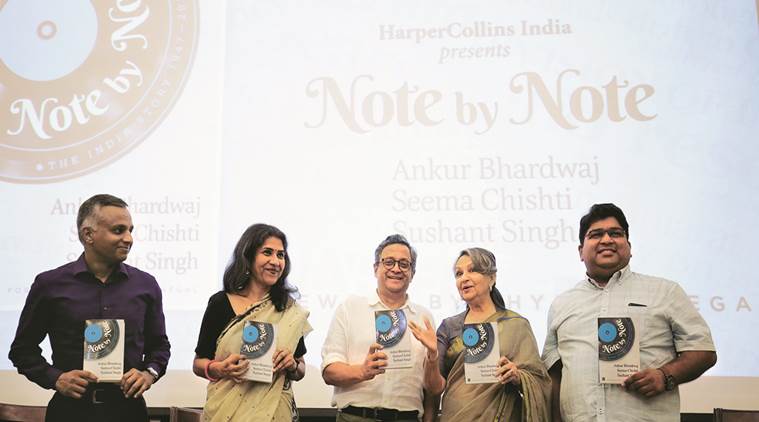Songs of India: Hindi film songs that captured the mood of the nation
Note by Note, which released in Delhi last week, encapsulates 70 years of independent India through its film music.
New Delhi | Updated: August 28, 2018 2:00:42 pm

(From left): Sushant Singh; Seema Chishti; Mukul Kesavan; Sharmila Tagore; Ankur Bhardwaj at the book launch in Delhi last week.
The year 1971 remains crucial in Indian history. The Congress, under the leadership of Indira Gandhi, had won a significant election, India had won a war against Pakistan, and under the leadership of Mujibur Rahman, Bangladesh was born. In the middle of all of this came SD Burman’s song Zindagi kaisi hai paheli hai, kabhi ye hasaye, kabhi ye rulaye. “The song provides a half-remembered echo of the times,” said historian Mukul Kesavan while introducing Note by Note. Published by HarperCollins, each chapter of the book focuses on a year and one Hindi film song that captured the mood of the nation at the time of its release.
Kesavan was in conversation with actor Sharmila Tagore and authors of the book, Seema Chishti, Deputy Editor, The Indian Express, Ankur Bhardwaj, Editor, Business Standard Online, and Sushant Singh, Deputy Editor, The Indian Express. “It defines the historical events that make up this timeline not only in terms of the political, the monumental or the solemn but everything that’s important to us,” said Kesavan.
At the book’s release last week at the Constitution Club of India in Delhi where the panel discussed the book, which is “an old-fashioned bioscope where the vignettes of India’s story over the past seven decades are played to Hindi film music”, Tagore impressed upon the fact that one needed to recognise the contribution of Hindi cinema to the nation.
“Hindi cinema has reflected the aspirations and dreams of this country. And songs were thoughts in these films. A lot of times, we remember the songs but forget the film. For example, people remember Madhuban mein Radhika, but can’t instantly recall the film.”
Chishti spoke about how the book was a result of intense political social discussions among the three authors and friends. During these, she’d often heard that “Sattar saal mein kuch nahi huya hai (Nothing has happened in these 70 years)”. “I disagreed with that. So we decided to do this as a tribute and testament to India. We thought we owed the demographic that is young, too anxious about its future, in an effort to register what has happened in 70 years in India,” said Chishti, who added that she and her co-authors chose songs because ‘music really unites India”. “Even if it isn’t a perfect fit, but there is something that echoes through,” she said. Singh called the book a travelogue and a journey and an “attempt to personalise the history and drawing the smells and sounds of years”.
While 1960, the decade of two wars and three Prime Ministers uses Pyar kiya toh darna kya (Mughal-e-Azam) as its metaphor, the RD Burman-and-Gulzar collaboration Tere bina zindagi se koyi shiqva from Aandhi finds itself as the song for 1975. While the film was controversial with many saying that it was based on the life of the then PM Indira Gandhi, the year was equally controversial with Gandhi’s declaration of the Emergency.
But should a tribute to India through its music be only in Hindi? Tagore summed it up best when she said, “It cuts across the language barrier as everyone sings Hindi songs, even outside of India.”






















No hay comentarios:
Publicar un comentario